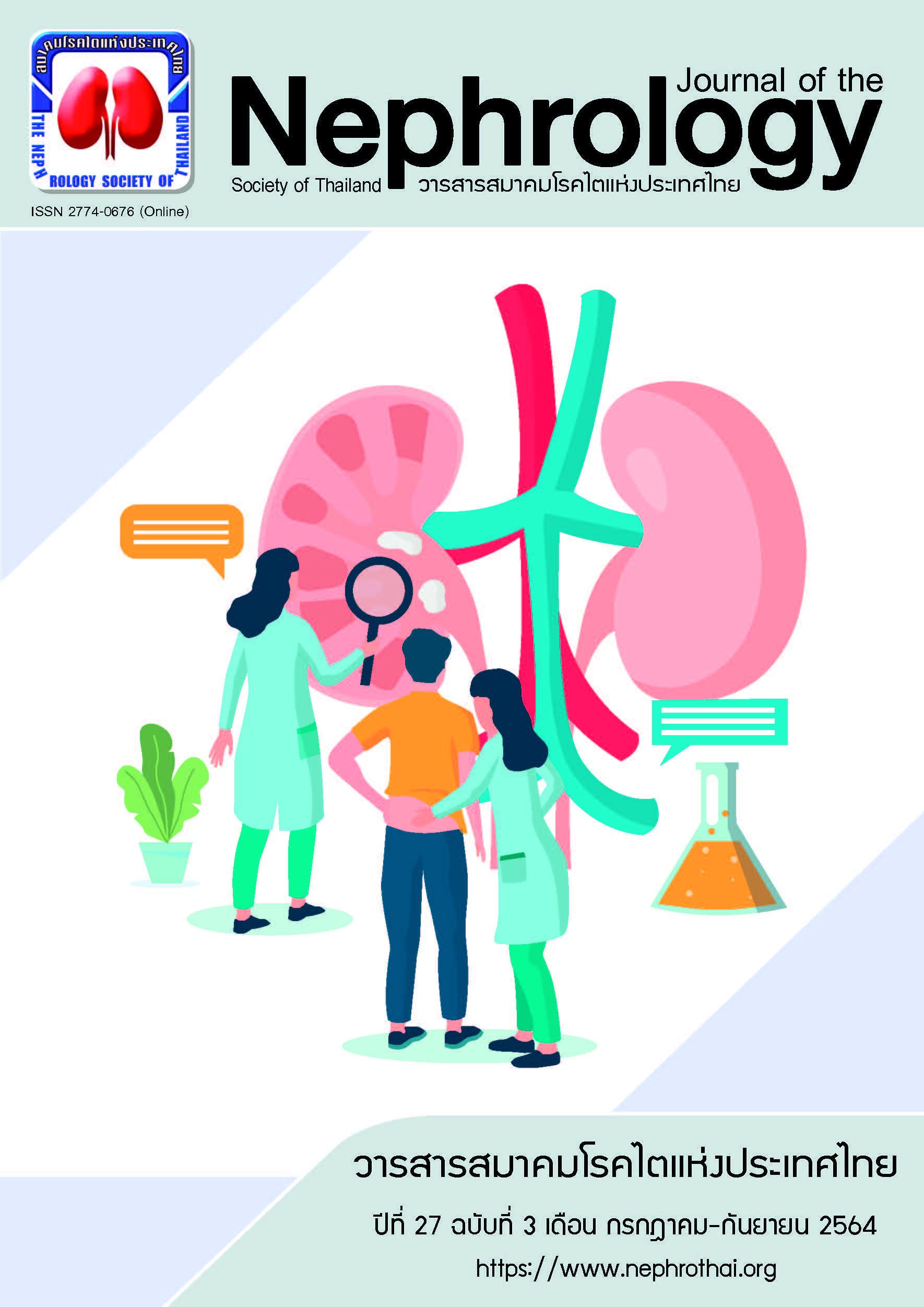Comparing efficacy between conventional and adapted methods of automated peritoneal dialysis among patients with end stage renal disease
Main Article Content
Abstract
Background: Automated PD (APD) involves cycles of repeated exchanges where conventional APD (APD-C) is typically set as the same dwell time and fill volume for every cycle. Adapted APD (APD-A) is a modified new method using a short dwell time with small fill volume then subsequently using a longer dwell time and a large fill volume. A few studies conducted by the same research group have found that APD-A might improve ultrafiltration (UF) and solute clearances. Because of the limited evidence, our study aimed to compare efficacies of APD-A and APD-C methods.
Methods: This study was a randomized crossover trial conducted in Srinagarind Hospital. The participants were randomly assigned by block of 4 to the APD-A or APD-C group in the first 6 weeks and then continued with the second 6-week period of crossover. The APD-A group was compared with the APD-C group on daily UF and efficacy of dialysis. Primary outcomes were weekly Kt/Vurea, weekly creatinine clearance (CrCL) and normalized CrCL (nCrCL). Secondary outcomes included UF, sodium clearance, phosphate clearance, and blood pressure control.
Results: Twenty-three patients were enrolled and randomized for the first 6-week period in the APD-A group (n=13) and APD-C (n=10). The mean age was 61.1±11.8 years. Comparison between two groups showed the APD-A group had significantly higher CrCL 48.47 (36.06–76.75) vs. 46.04 (32.23–61.71) L/week (median difference 2.43 L/week, P = 0.022) and nCrCl 53.24 (45.87–72.91) vs. 49.44 (37.94–58.15) L/week/1.73m2 (median difference 3.80 L/week/1.73 m2, P = 0.02) and higher serum bicarbonate level (25.5±2.8 vs. 24.1±2.4 mEq/L, P = 0.01) and hemoglobin (10.93±1.82 vs. 10.21±1.93 g/dL, P= 0.04). No significant differences were found of other parameters and blood pressure control. No significance was observed of carry-over, period and sequence effects on treatment
outcomes.
Conclusion: The APD-A group had higher efficacy in CrCL, and nCrCL compared with the APD-C group. However, no demonstrated improvement was found in other clearances and UF. Generalized use of APD-A still requires more evidence from long term studies to support its benefits.
Article Details

This work is licensed under a Creative Commons Attribution-NonCommercial-NoDerivatives 4.0 International License.
This article is published under CC BY-NC-ND 4.0 license, which allows for non-commercial reuse of the published paper as long as the published paper is fully attributed. Anyone can share (copy and redistribute) the material in any medium or format without having to ask permission from the author or the Nephrology Society of Thailand.
References
Fischbach M, Issad B, Dubois V, Taamma R. The beneficial influence on the effectiveness of automated peritoneal dialysis of varying the
dwell time (short/long) and fill volume (small/large): a randomized controlled trial. Perit Dial Int. 2011;31(4):450-8.
Fischbach M, Zaloszyc A, Schaefer B, Schmitt C. Adapted automated peritoneal dialysis. Adv Perit Dial. 2014;30:94-7.
Guest S, Leypoldt JK, Cassin M, Schreiber M. Kinetic Modeling of Incremental Ambulatory Peritoneal Dialysis Exchanges. Perit Dial Int. 2017;37(2):205-11.
Fischbach M, Schmitt CP, Shroff R, Zaloszyc A, Warady BA. Increasing sodium removal on peritoneal dialysis: applying dialysis mechanics to the peritoneal dialysis prescription. Kidney Int. 2016;89(4):761-6.
Oberg CM, Rippe B. Is Adapted APD Theoretically More Efficient than Conventional APD? Perit Dial Int. 2017;37(2):212-7.
Dombros N, Dratwa M, Feriani M, Gokal R, Heimburger O, Krediet R, et al. European best practice guidelines for peritoneal dialysis. 7 Adequacy of peritoneal dialysis. Nephrol Dial Transplant. 2005;20 Suppl 9:ix24-ix7.
Flessner MF. Peritoneal transport physiology: insights from basic research. J Am Soc Nephrol. 1991;2(2): 122-35.
Rippe B, Venturoli D, Simonsen O, de Arteaga J. Fluid and electrolyte transport across the peritoneal membrane during CAPD according to the three-pore model. Perit Dial Int. 2004;24(1):10-27.
Waniewski J, Stachowska-Pietka J, Flessner MF. Distributed modeling of osmotically driven fluid transport in peritoneal dialysis: theoretical and computational investigations. Am J Physiol Heart Circ Physiol. 2009;296(6):H1960-8.
Keshaviah P, Emerson PF, Vonesh EF, Brandes JC. Relationship between body size, fill volume, and mass transfer area coefficient in peritoneal dialysis. J Am Soc Nephrol. 1994;4(10):1820-6.
Fischbach M, Haraldsson B. Dynamic changes of the total pore area available for peritoneal exchange in children. J Am Soc Nephrol. 2001;12(7):1524-9.
Dejardin A, Robert A, Goffin E. Intraperitoneal pressure in PD patients: relationship to intraperitoneal volume, body size and PD-related complications. Nephrol Dial Transplant. 2007;22(5):1437-44.
Lo WK, Ho YW, Li CS, Wong KS, Chan TM, Yu AW, et al. Effect of Kt/V on survival and clinical outcome in CAPD patients in a randomized prospective study. Kidney Int. 2003;64(2):649-56.
Paniagua R, Amato D, Vonesh E, Correa-Rotter R, Ramos A, Moran J, et al. Effects of increased peritoneal clearances on mortality rates in
peritoneal dialysis: ADEMEX, a prospective, randomized, controlled trial. J Am Soc Nephrol. 2002;13(5):1307-20.
Fischbach M, Dheu C, Seuge-Dargnies L, Delobbe JF. Adequacy of peritoneal dialysis in children: consider the membrane for optimal prescription. Perit Dial Int. 2007;27 Suppl 2:S167-70.
Granja CA, Juergensen P, Finkelstein FO. Phosphate balance in peritoneal dialysis patients: role of ultrafiltration. Contrib Nephrol. 2009;163:198-205.


